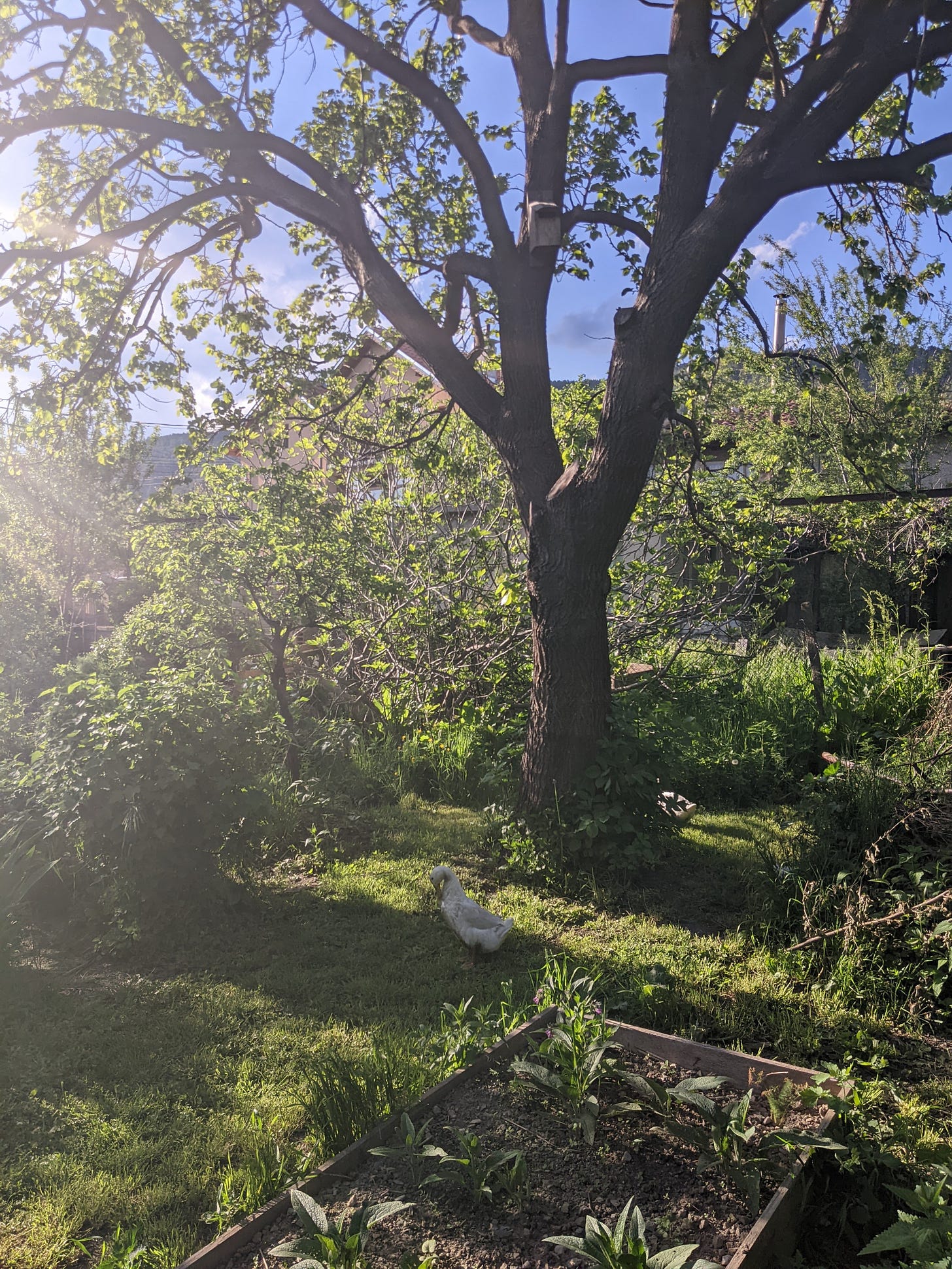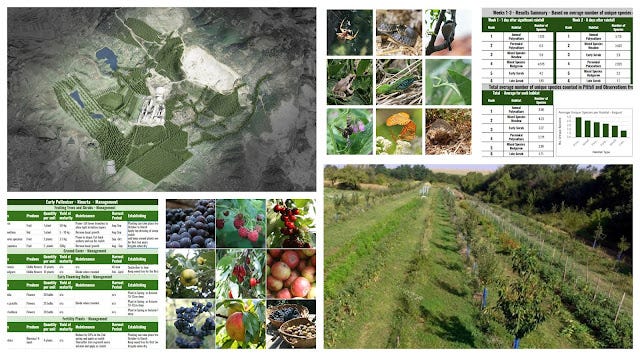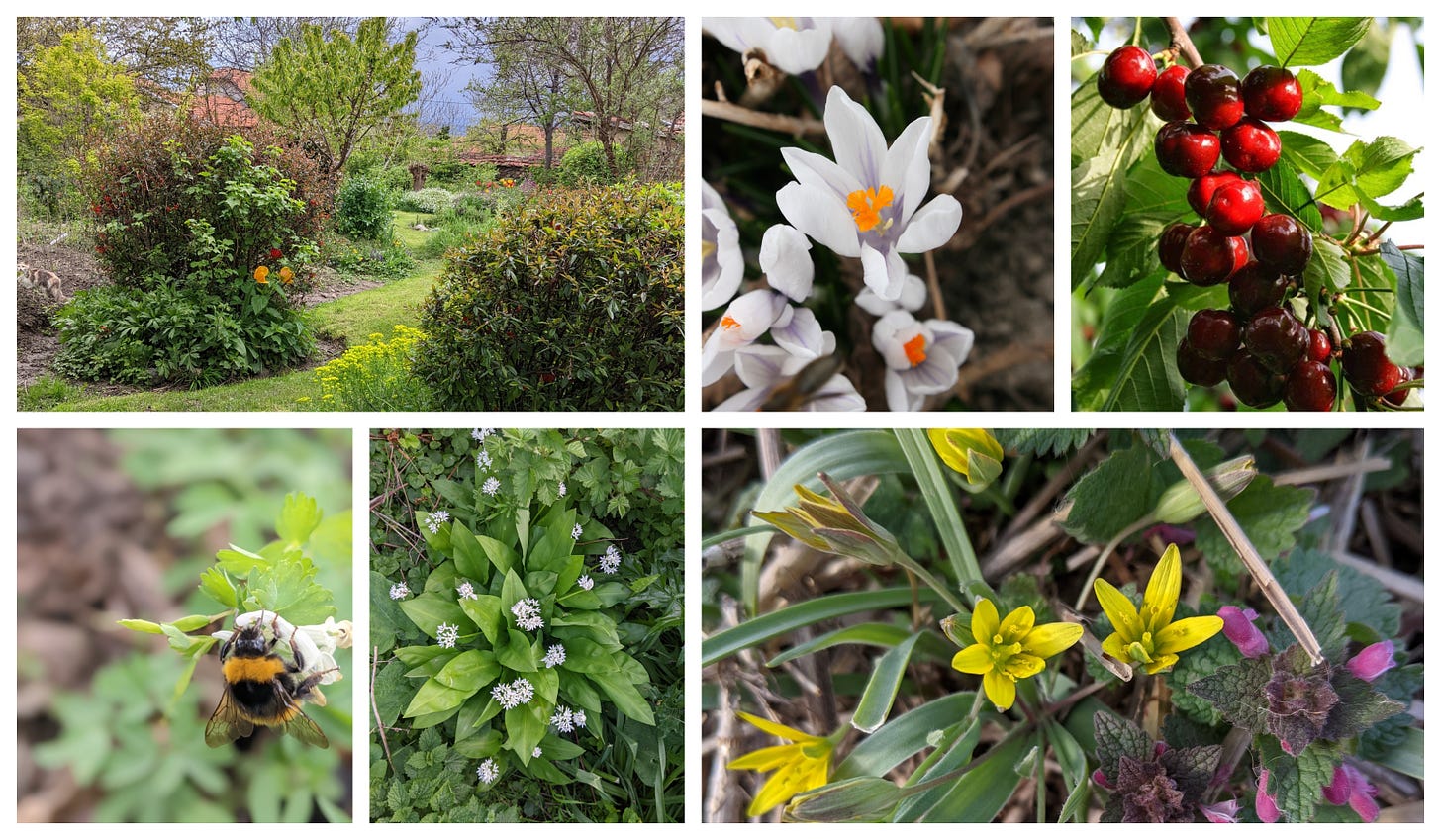Welcome to Part 6 of our series, where we explore plant species from various layers of our forest gardens and around the world. Discover the local wildlife the gardens attract, and gain valuable insights into designing, building, and managing your regenerative landscapes.
Forest Garden Plants
Canopy Layer - Morus alba is one of the most reliable plants in our forest garden, growing fast, producing year after year (more than we can consume) and requiring very little care, in fact often thriving with neglect. We lift the lower branches of the largest tree in the garden and will thin the crown every 5 - 7 years to allow more light under the canopy where plenty of other wild and cultivated plants can grow alongside the tree.
Our Mulberry trees will provide the first ripe fruits in early June (if the spring has been warm) and the last ones in Early Aug so it’s a pretty long fruiting season. For a more details on Morus spp. see our essential growling guide here
Shrub Layer - The Berberis genus, commonly known as barberries, includes a wide variety of species, the fruit of most, if not all, members of this genus are more or less edible and can be eaten in quantity. They’ll grow well in the understory but will fruit prolifically when grown in full sun and can make a great hedging. I’ve seen hedges completely decimated by Berberis sawfly - Arge berberidis in the UK so they are probably better off used in a mix within a polyculture hedge
The genus Berberis from Berberidaceae includes about 500 species worldwide, some of which are widely cultivated in the north-eastern regions of Iran. This genus consists of spiny deciduous evergreen shrubs, characterized by yellow wood and flowers. Here are a few example species
Berberis vulgaris is probably the most commonly grown in Europe and produces edible berries that are used in various culinary applications, including jams, jellies, and as a tangy garnish.
Berberis thunbergii are technically edible, but are generally not consumed due to their bitter taste and small size. They do however provide for wildlife. The plants have a striking deep red foliage in the early season that lightens as the season progresses. I like to include some red foliage species in our gardens to create some contrast against the sea of Spring green.
Berberis integerrima is an intriguing species harvested from the wild in its native territory of Iran. Cultivars such as 'Bidaneh' have been developed in Iran, featuring notably large berries. The dried fruits, known locally as Zereshk, serve both culinary and medicinal purposes. In Persian cuisine, they are often lightly fried with butter and added to sweet sauces to impart a delightful tangy flavor.
Herb Layer - Verbascum ( common name - mullein / velvet plant) is one of my favorite wild herbs that grow around and within our gardens. As well as perennial there are biennial and annual plants in this genus but all are easily recognizable by their light green furry leaves that start to emerge in the spring where they are lying close the ground

There are over 40 species of Verbascum in Bulgaria and 20 of these are protected according to THE BULGARIAN FLORA ONLINE and the species that grows most abundantly in our gardens is Verbascum thapsus. Even within this species there is incredible diversity to how the inflorescence looks, as you can see in the below photo.
It's a great plant for dry gardens and is very much appreciated by ornamental gardeners as well as herbalists. Mullein tea is a traditional treatment for respiratory problems, such as chest colds, bronchitis and asthma. Leaf poultices have been used in the past to treat bruises, tumors, rheumatic pains and Mullein flower oil (made by steeping the flowers in warm olive oil) also has been used for treating hemorrhoids, as well as earaches. It’s also smokable and when I used to smoke I would pick leaves from 1st year plants , dry them for a few days in the shade and then chop them finely and mix with tobacco. It was a nice smoke.
Ground Layer - Allium schoenoprasum - Chives is a fascinating herb with a rich history of culinary and medicinal use. These are great plants for the forest garden, once established they hold their own and require little maintenance serving as great ground cover. They taste great, look great and are extremally attractive to a range of beneficial invertebrates. We find they can grow well in dappled shade and do really well in full sun and although they will cope with some drought, they will flourish if watered well throughout the dry season.
They are very easy to divide but it’s best to let them grow 3 or 4 years before dividing, this way the original plants recovers fast and the division can be planted out immediately and should establish within the first season.
Chives are originally from Asia and have made their way around to nearly all parts of world. The Shennong Bencao Jing, a Chinese medical text that was written sometime around 200 BC mentions chives as a medicinal herb that can be used to treat a variety of ailments, including stomachache, diarrhea, and fever. The ancient silk road traders would have probably brought the plant along with them incase of illness and Chives were probably being moved around courtesy of us hominids for the last 3000 years or so.
More on our forest garden plants here and fruit and nut cultivars we grow here
Regenerative Landscape Design - Online Interactive Course
Want to learn how to design, build and manage regenerative landscapes? Join us on our Regenerative Landscape Design - Online Interactive Course. We look forward to providing you with the confidence, inspiration, and opportunity to design, build and manage regenerative landscapes, gardens, and farms that produce food and other resources for humans while enhancing biodiversity.
You can find the course details here and at the moment we have a $300 ( 20%) discount for full enrollment to the course. Just use RLD2024 in the promo code section of the registration form to receive your discount.
Wildlife
A great way to encourage beneficial insects into a raised bed vegetable garden is to integrate sections of fallow patches within the beds.
We practiced this in our six 1.3 x 26m long market garden beds. Wild plants will natural emerge and can be left to grow with the only maintenance being cutting back the sides when the growth starts to impede upon pathways.
Here is an example layout of fallow patches within a raised bed garden. The example shown below has 180 m2 of cultivated land and with 6 fallow patches covering 14.4 m2 this is less than 10 % of the land dedicated to habitat and provides a refuge for wildlife and beneficial insects within a intensively cultivated area. The plan assumes that there is no other wildlife habitat around the perimeter of the garden. If there were wildlife habitat around the perimeter of the garden the number of fallow patches may be reduced and concentrated to the inner part of the garden.
As long as we remove the fast growing rhizomatous perennial grasses in the first season a number of wild plants that are extremely attractive to wildlife will naturally emerge from our soils.

Beneficial insects such as Hoverflies, Ladybugs, Spiders and ground beetles are frequent visitors to the patches and all assist with pollination and/or pest predation. If you don’t have a diverse mix of plants in your soil seed bank , than sowing with a wildflower mix will do the trick and within a season or two you should have enough seed stored in the soil for natural regeneration.
Welcome to our Online Store where you can find Forest Garden/ Permaculture plants, seeds, bulbs, and Polyculture multi-packs along with digital goods and services such as Online Courses, Webinars and eBooks. We hope you enjoy the store and find something you like. It's your purchases that keep our Project going.
You can also find our full list of trees. shrubs and herbs for forest gardens on our nursery website.
Wild Polyculture
During a trip to Turkiye a few summers back I came across a great example of wild polyculture in a semi-arid region of Cappadocia, Pigeon Valley.
Although the area is relatively barren, plant life in the valleys and within natural terraces grow well due to volcanic soil that is fine grained but porous soaking up rainfall during winter and spring and storing the water deep in the soil where the plants can access it during high summer.
I found a remarkable combination of support plants including nitrogen fixing - Colutea arborescens - Bladder Senna, deep rooted mineral repositor - Echinops spp. Globe Thistle (among many other herbs) and variety of shrubs and trees that provide a succession of fruit from mid Summer - late Autumn including Berberis spp. Barberry, Hippophae rhamnoides - Sea Buckthorn and Cydonia oblonga - Quince. The upper canopy consisted on Willow - Salix spp. (some of which were dying or dead) with the canopies of the Salix often packed with Viscum album - European Mistletoe. Mistletoe is a hemiparasitic plant that relies on a host tree for water and nutrients but will do the photosynthesizing on its own.
I only caught a mid summer snapshot of this polyculture and I’m sure many more annual and perennial herbs grow throughout the season and probably a spring and autumn bulb layer will make an appearance.
Want to learn more about Regenerative Landscape Design? Join The Bloom Room!
The Bloom Room is designed to create a space for more in-depth learning, for sharing projects and ideas, for seeking advice and discovering opportunities.
Ultimately, it aims to build a more intimate, interactive, and actionable relationship between members, a way for the Bloom Room community to support each other’s projects and learning journeys, and to encourage and facilitate the design, build, and management of more regenerative landscapes across our planet.
What you can expect as a member of the Bloom Room
As a member of the Bloom Room you can expect;
Access to an interactive forum where you can ask questions, direct what type of content you would like to see as well as share your own content and projects.
Monthly live session featuring general Q&A and tutorials on design software for creating and presenting polycultures.
Live session every month for members to showcase your projects, plans, designs, and gardens, with guest speakers from the community.
Full Access to all of the content on Substack
A 50% discounts on all of our online courses
Future opportunities to join our Global Regenerative Landscape Design and Consultancy Service, with potential roles for those with the will and skill to join our design team.
An opportunity to take part in the group ownership of a Regenerative Landscape. You will find more details on that here.
Become a paid subscriber to our Substack to join. The annual subscription is currently $70 and the monthly subscription is $7 (monthly subscription excludes discounts for products and services) . You can join here, we look forward to meeting you!
Support Our Project
If you appreciate the work we are doing you can show your support in several ways.
Become a member of the Bloom Room. A $70 annual or $7 per month subscription to our Substack provides you with access to live sessions, design tutorials, a members forum and more, see details here.
Make a purchase of plants or seeds from our Nursery or Online Store
Joining us for one of our Practical Courses or Online Courses
Comment, like, and share our content on social media.
If you appreciate the work we are doing you can show your support in several ways.
Become a member of the Bloom Room. A $70 annual or $7 per month subscription to our Substack provides you with access to live sessions, design tutorials, a members forum and more, see details here.
Make a purchase of plants or seeds from our Nursery or Online Store
Joining us for one of our Practical Courses or Online Courses
Comment, like, and share our content on social media.
We offer a diversity of plants and seeds for permaculture, forest gardens, and regenerative landscapes including a range of fruit and nut cultivars. We Deliver all over Europe from Nov - March. - Give a happy plant a happy home :)
Welcome to our Online Store where you can find Forest Garden/ Permaculture plants, seeds, bulbs, and Polyculture multi-packs along with digital goods and services such as Online Courses, Webinars and eBooks. We hope you enjoy the store and find something you like. It's your purchases that keep our Project going.
You can also find our full list of trees. shrubs and herbs for forest gardens on our nursery website.


























